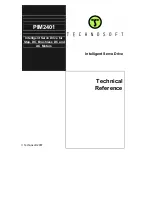
8 Troubleshooting
8-22
Servomotor
Vibrates at
Frequency of
Approx. 200 to
400 Hz.
Unbalanced servo gains
Check to see if the servo gains have
been correctly adjusted.
Execute the advanced autotuning.
Speed loop gain value (Pn100) too
high.
Check the speed loop gain (Pn100).
Factory setting: Kv = 40.0 Hz
Reduce the speed loop gain
(Pn100).
Position loop gain value (Pn102)
too high.
Check the position loop gain
(Pn102).
Factory setting: Kp = 40.0/s
Reduce the position loop gain
(Pn102).
Incorrect speed loop integral time
constant (Pn101)
Check the speed loop integral time
constant (Pn101).
Factory setting: Ti = 20.0 ms
Correct the speed loop integral time
constant (Pn101).
Incorrect moment of inertia ratio
(Pn103)
Check the moment of inertia ratio
(Pn103).
Correct the moment of inertia ratio
(Pn103).
High Motor Speed
Overshoot on
Starting and
Stopping
Unbalanced servo gains
Check to see if the servo gains have
been correctly adjusted.
Execute the advanced autotuning.
Speed loop gain value (Pn100) too
high
Check the speed loop gain (Pn100).
Factory setting: Kv = 40.0 Hz
Reduce the speed loop gain
(Pn100).
Position loop gain value (Pn102)
too high
Check the position loop gain
(Pn102).
Factory setting: Kp = 40.0/s
Reduce the position loop gain
(Pn102).
Incorrect speed loop integral time
constant (Pn101)
Check the speed loop integral time
constant (Pn101).
Factory setting: Ti = 20.0 ms
Correct the speed loop integral time
constant (Pn101).
Incorrect moment of inertia ratio
data (Pn103)
Check the moment of inertia ratio
(Pn103).
Correct the moment of inertia ratio
(Pn103).
Absolute Encoder
Position
Difference Error
(The position
saved in the host
controller when
the power was
turned OFF is
different from the
position when the
power was next
turned ON.)
Noise interference due to incorrect
cable specifications of encoder
cable.
The encoder cable must be tinned
annealed copper shielded twisted-
pair or screened unshielded twisted-
pair cable with a core of 0.12 mm
2
min.
Use the specified encoder cable.
Noise interference due to length of
encoder cable.
Check the length of the encoder
cable.
The encoder cable must be no more
than 50 m.
Noise interference due to damaged
encoder cable.
Check if the encoder cable is bent
and the sheath is damaged.
Replace the encoder cable and cor-
rect the cable layout.
Excessive noise to the encoder
cable.
Check if the encoder cable is bun-
dled with a high-current line or near
a high-current line.
Correct the cable layout so that no
surge is applied.
FG potential varies because of
influence of machines such as weld-
ers at the servomotor.
Check if the machines are correctly
grounded.
Ground machines correctly, and
prevent diversion to the FG on the
encoder side.
SERVOPACK pulse counting error
due to noise interference
Check if there is noise interference
on the I/O signal line from the
encoder.
Take measures against noise in the
encoder wiring.
Excessive vibration and shock to
the encoder
Check if vibration from the machine
occurred or servomotor installation
is incorrect (mounting surface accu-
racy, fixing, alignment, etc.).
Reduce vibration from the machine,
or secure the servomotor installa-
tion.
An encoder fault occurred.
−
Replace the servomotor.
A SERVOPACK fault occurred.
(The pulse count does not change.)
−
Replace the SERVOPACK.
Host controller multiturn data read-
ing error
Check the error detection section of
the host controller.
Correct the error detection section
of the host controller.
Check if the host controller is exe-
cuting data parity checks.
Execute a multiturn data parity
check.
Check noise in the cable between
the SERVOPACK and the host con-
troller.
Take measures against noise, and
again execute a multiturn data par-
ity check.
(cont’d)
Problem
Probable Cause
Investigative Actions
Corrective Actions
















































